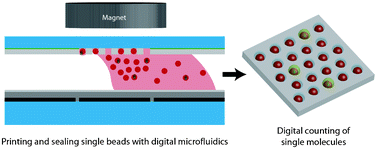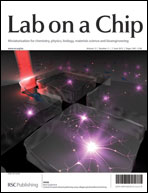Digital microfluidics is introduced as a novel platform with unique advantages for performing single-molecule detection. We demonstrate how superparamagnetic beads, used for capturing single protein molecules, can be printed with unprecedentedly high loading efficiency and single bead resolution on an electrowetting-on-dielectric-based digital microfluidic chip by micropatterning the Teflon-AF surface of the device. By transporting droplets containing suspended superparamagnetic beads over a hydrophilic-in-hydrophobic micropatterned Teflon-AF surface, single beads are trapped inside the hydrophilic microwells due to their selective wettability and tailored dimensions. Digital microfluidics presents the following advantages for printing and sealing magnetic beads for single-molecule detection: (i) droplets containing suspended beads can be transported back and forth over the array of hydrophilic microwells to obtain high loading efficiencies of microwells with single beads, (ii) the use of hydrophilic-in-hydrophobic patterns permits the use of a magnet to speed up the bead transfer process to the wells, while the receding droplet meniscus removes excess beads off the chip surface and thereby shortens the bead patterning time, and (iii) reagents can be transported over the printed beads multiple times, while capillary forces and a magnet hold the printed beads in place. High loading efficiencies (98% with a CV of 0.9%) of single beads in microwells were obtained by transporting droplets of suspended beads over the array 10 times in less than 1 min, which is much higher than previously reported methods (40–60%), while the total surface area needed for performing single-molecule detection can be decreased. The performance of the device was demonstrated by fluorescent detection of the presence of the biotinylated enzyme β-galactosidase on streptavidin-coated beads with a linear dynamic range of 4 orders of magnitude ranging from 10 aM to 90 fM.

You have access to this article
 Please wait while we load your content...
Something went wrong. Try again?
Please wait while we load your content...
Something went wrong. Try again?


 Please wait while we load your content...
Please wait while we load your content...